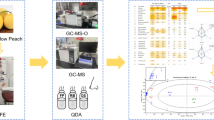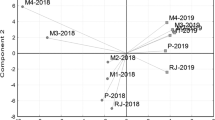Abstract
Citrus, as one of the most popular fruits in the world, besides their pulp, their peel has a unique flavor and rich value. Compared with pulp, the aroma of citrus peel is more intense and unique, and there are few comprehensive studies on the difference between citrus peel and pulp aroma properties. In this study, the aroma characterization of September Red navel orange (SRO) pulp (OPU) and peel (OPE) was investigated by gas chromatography–mass spectrometry (GC–MS), gas chromatography–olfactometry (GC–O), odor activity value (OAV) determination and sensory analysis. Terpenes, alcohols, and aldehydes were found as the major volatile compounds in SRO, meanwhile, 23 key aroma components were detected, with 15 of them present in both OPU and OPE, and the concentration of the 15 substances in OPE was 1–1700 times higher than in OPU. The quantitative descriptive analyses (QDA) sensory analysis results showed there were six main fragrances present, with “fruity”, “green”, “floral”, and “woody” significantly stronger (p < 0.05) in OPE than in OPU. Finally, (E)-2-pentenal, ethyl butyrate, (E)-2-decenal, styrene, (Z)-3-hexen-1-ol, (Z)-2-hexen-1-ol, linalool, nerol, γ-terpinene, and acetic acid were summarized as the key aroma compounds by aroma recombination and omission experiments. This study expands our knowledge of orange aroma characterization and not only provides theoretical basis for natural fruit flavor products, but also helps to promote the healthy development of the flavor industry.
Graphical Abstract





Similar content being viewed by others
References
**ang Z, Chen X, Qian C, He K, **ao X (2020) Determination of volatile flavors in fresh navel orange by multidimensional gas chromatography quadrupole time of flight mass spectrometry. Anal Lett 53(4):614–626. https://doi.org/10.1080/00032719.2019.1662429
Xu G, Liu D, Chen J, Ye X, Ma Y, Shi J (2008) Juice components and antioxidant capacity of citrus varieties cultivated in China. Food Chem 106(2):545–551. https://doi.org/10.1016/j.foodchem.2007.06.046
Sellami I, Mall V, Schieberle P (2018) Changes in the key odorants and aroma profiles of hamlin and valencia orange juices not from concentrate (NFC) during chilled storage. J Agric Food Chem 66(28):7428–7440. https://doi.org/10.1021/acs.jafc.8b02257
Paramasivam S, Alva AK, Hostler KH, Easterwood GW, Southwell JS (2000) Fruit nutrient accumulation of four orange varieties during fruit development. J Plant Nutr 23(3):313–327. https://doi.org/10.1080/01904160009382018
Tounsi MS, Mhamdi B, Kchouk ML, Marzouk B (2010) Juice aroma evolution during blood orange maturity. J Essent Oil Res 22(6):471–476. https://doi.org/10.1080/10412905.2010.9700375
Gabriella R, DA Schmutzer M, Moldovan Z, Mirel V (2016) Characterization of the flavor profile of orange juice by solid-phase microextraction and gas chromatography-mass spectrometry. Anal Lett 49(16):2540–2559. https://doi.org/10.1080/00032719.2015.1131707
**ao Z, Wu Q, Niu Y, Wu M, Zhu J, Zhou X, Chen X, Wang H, Li J, Kong J (2017) Characterization of the key aroma compounds in five varieties of mandarins by gas chromatography-olfactometry, odor active values, aroma recombination, and omission analysis. J Agric Food Chem 65(38):8392–8401. https://doi.org/10.1021/acs.jafc.7b02703
Goh RMV, Pua A, Ee KH, Huang Y, Liu SQ, Lassabliere B, Yu B (2021) Investigation of changes in non-traditional indices of maturation in Navel orange peel and juice using GC–MS and LC-QTOF/MS. Food Res Int 148:110607. https://doi.org/10.1016/j.foodres.2021.110607
Qiao Y, **e BJ, Zhang Y, Zhang Y, Fan G, Yao XL, Pan S (2008) Characterization of aroma active compounds in fruit juice and peel oil of **chen sweet orange fruit (Citrus sinensis (L.) Osbeck) by GC-MS and GC-O. Molecules 13(6):1333–1344. https://doi.org/10.3390/molecules13061333
Teixeira F, Santos BAD, Nunes G, Soares JM, Amaral LAD, Souza GHO, Resende JTV, Menegassi B, Rafacho BPM, Schwarz K, Santos EFD, Novello D (2020) Addition of orange peel in orange jam: evaluation of sensory, physicochemical, and nutritional characteristics. Molecules 25(7):1670. https://doi.org/10.3390/molecules25071670
Wang J, Shi J, Zhu Y, Ma W, Yan H, Shao C, Wang M, Zhang Y, Peng Q, Chen Y, Lin Z (2022) Insights into crucial odourants dominating the characteristic flavor of citrus-white teas prepared from citrus reticulata Blanco “Chachiensis” and Camellia sinensis “Fudingdabai.” Food Chem 377(30):132048. https://doi.org/10.1016/j.foodchem.2022.132048
Geraci A, Stefano VD, Martino ED, Schillaci D, Schicchi R (2016) Essential oil components of orange peels and antimicrobial activity. Nat Prod Res 31(6):653–659. https://doi.org/10.1080/14786419.2016.1219860
Liu X, Liu B, Jiang D, Zhu S, Shen W, Yu X, Xue Y, Liu M, Feng J, Zhao X (2019) The accumulation and composition of essential oil in kumquat peel. Sci Hortic 252:121–129. https://doi.org/10.1016/j.scienta.2019.03.042
Ni H, Hong P, Ji HF, Sun H, Chen YH, **ao AF, Chen F (2015) Comparative analyses of aromas of fresh, naringinase-treated and resin-absorbed juices of pummelo by GC-MS and sensory evaluation. Flavour Fragr J 30(3):245–253. https://doi.org/10.1002/ffj.3239
Dreher JG, Rouseff RL, Naim M (2003) GC−olfactometric characterization of aroma volatiles from the thermal degradation of thiamin in model orange juice. J Agric Food Chem 51(10):3097–3102. https://doi.org/10.1021/jf034023j
Xu X, Xu R, Jia Q, Feng T, Huang Q, Ho CT, Song S (2019) Identification of dihydro-β-ionone as a key aroma compound in addition to C8 ketones and alcohols in Volvariella volvacea mushroom. Food Chem 293(30):333–339. https://doi.org/10.1016/j.foodchem.2019.05.004
**ao Z, Chen L, Niu Y, Zhu J, Zhang J, Deng J (2021) Evaluation of the interaction between esters and sulfur compounds in pineapple using feller’s additive model, OAV, and odor activity coefficient. Food Anal Method 14:1714–1729. https://doi.org/10.1007/s12161-021-02001-8
Zhu J, Niu Y, **ao Z (2020) Characterization of the key aroma compounds in Laoshan green teas by application of odour activity value (OAV), gas chromatography-mass spectrometry-olfactometry (GC-MS-O) and comprehensive two-dimensional gas chromatography mass spectrometry (GC×GC-qMS). Food Chem 339:128136. https://doi.org/10.1016/j.foodchem.2020.128136
Gemert LJV (2011) Odour thresholds: Compilations of Odour Threshold Values in Air, Water and Other Media. Oliemans Punter
ISO 8586 (2012) Sensory analysis-General guidelines for the selection, training and monitoring of selected assessors and expert sensory assessors
Zhu J, Chen F, Wang L, Niu Y, Yu D, Shu C, Chen H, Wang H, **ao Z (2015) Comparison of aroma-active volatiles in oolong tea infusions using GC-olfactometry, GC-FPD, and GC-MS. J Agric Food Chem 63(34):7499–7510. https://doi.org/10.1021/acs.jafc.5b
Niu Y, Wang P, **ao Z, Zhu J, Sun X, Wu R (2019) Evaluation of the perceptual interaction among ester aroma compounds in cherry wines by GC-MS, GC-O, odor threshold and sensory analysis: An insight at the molecular level. Food Chem 275:143–153. https://doi.org/10.1016/j.foodchem.2018.09.102
Zhang W, Lao F, Bi S, Pan X, Pang X, Hu X, Liao X, Wu J (2020) Insights into the major aroma-active compounds in clear red raspberry juice (Rubus idaeus L. cv. Heritage) by molecular sensory science approaches. Food Chem 336:127721. https://doi.org/10.1016/j.foodchem.2020.127721
Yang P, Song H, Wang L, **g H (2019) Characterization of key aroma-active compounds in black garlic by sensory-directed flavor analysis. J Agric Food Chem 67(28):7926. https://doi.org/10.1021/acs.jafc.9b03269
Zheng Y, Sun B, Zhao M, Zheng F, Huang M, Sun J, Sun X, Li H (2016) Characterization of the key odorants in Chinese Zhima aroma-type baijiu by gas chromatography-olfactometry, quantitative measurements, aroma recombination, and omission studies. J Agric Food Chem 64(26):5367–5374. https://doi.org/10.1021/acs.jafc.6b01390
Florentino-Ramos E, Villa-Ruano N, Hidalgo-Martinez D, Ramirez-Meraz M, Mendez-Aguilar R, Velasquez-Valle R, Zepeda-Vallejo LG, Pérez-Hernández N, Becerra-Martínez E (2019) 1H NMR-based fingerprinting of eleven mexican capsicum annuum cultivars. Food Res Int 121:12–19. https://doi.org/10.1016/j.foodres.2019.03.025
Rodriguez A, Shimada T, Cervera M, Alquezar B, Gadea J, Gomez-Cadenas A, Ollas CJ, Rodrigo MJ, Zacarías L, Peña L (2013) Terpene down-regulation triggers defense responses in transgenic orange leading to resistance against fungal pathogens. Plant Physiol 164(1):321–339. https://doi.org/10.1104/pp.113.224279
Salles C, Jallageas JC, Crouzet JC (1993) HPLC separation of fruit diastereoisomeric monoterpenyl glycosides. J Essent Oil Res 5(4):381–390. https://doi.org/10.1080/10412905.1993.9698247
Bazemore R, Rouseff R, Naim M (2003) Linalool in orange juice: origin and thermal stability. J Agric Food Chem 51(1):196. https://doi.org/10.1021/jf0257291
Cao J, Jiang X, Chen Q, Zhang H, Sun H, Zhang WM, Li C (2019) Oxidative stabilities of olive and camellia oils: possible mechanism of aldehydes formation in oleic acid triglyceride at high temperature. LWT Food Sci Technol 118:108858. https://doi.org/10.1016/j.lwt.2019.108858
Li X, Ren JN, Fan G, Pan SY (2018) Changes of aroma compounds and qualities of freshly-squeezed orange juice during storage. J Food Sci Technol 55(11):4530–4543. https://doi.org/10.1007/s13197-018-3389-2
Attaway JA, Oberbacher MF (1968) Studies on the aroma of intact hamlin oranges. J Food Sci 33(3):287–289. https://doi.org/10.1111/j.1365-2621.1968.tb01369.x
Averbeck M, Schieberle PH (2009) Characterisation of the key aroma compounds in a freshly reconstituted orange juice from concentrate. Eur Food Res Technol 229(4):611–622. https://doi.org/10.1007/s00217-009-1082-4
Deterre S, Leclair C, Bai J, Baldwin EA, Narciso JA, Plotto A (2016) Chemical and sensory characterization of orange (Citrus sinensis) pulp, a by - product of orange juice processing using gas - chromatography - olfactometry. J Food Qual 39(6):826–838. https://doi.org/10.1111/jfq.12226
Fan G, Xu X, Qiao Y, Xu Y, Zhang Y, Li L, Pan S (2009) Volatiles of orange juice and orange wines using spontaneous and inoculated fermentations. Eur Food Res Technol 228(6):849. https://doi.org/10.1007/s00217-008-0992-x
**ao Z, Chen H, Niu Y, Zhu J (2021) Characterization of the aroma-active compounds in banana (Musa AAA Red green) and their contributions to the enhancement of sweetness perception [J]. J Agric Food Chem 69(50):15301–15313. https://doi.org/10.1021/acs.jafc.1c06434
Niu Y, Zhang J, **ao Z, Zhu J (2020) evaluation of the perceptual interactions between higher alcohols and off-odor acids in laimao baijiu by σ–τ plot and partition coefficient. J Agric Food Chem 68(50):14938–14949. https://doi.org/10.1021/acs.jafc.0c05676
Niu Y, Deng J, **ao Z, Zhu J (2021) Characterization of the major aroma-active compounds in peach (Prunus persica L. Batsch) by gas chromatography-olfactometry, flame photometric detection and molecular sensory science approaches. Food Res Int 10:161–169. https://doi.org/10.1016/j.foodres.2021.110457
Acknowledgements
This work was supported by the National Natural Science Foundation of China (31972196), Initial Scientific Program for Introduced Talents of Shanghai Institute of Technology (10120K226080-A06), Shanghai Academic Research Leader (21XD1423800), and Capacity building project of local universities Science and Technology Commission of Shanghai Municipality (21010503900).
Author information
Authors and Affiliations
Contributions
ZX: conceptualization, methodology. JH and JX: validation, formal analysis, investigation, writing—original draft. YN: conceptualization, methodology. JZ: writing—review & editing, project administration.
Corresponding author
Ethics declarations
Conflict of interest
The authors declare that there is no conflict of interests regarding the publication of this article.
Ethical approval
This article does not contain any studies with human or animals and complies with ethical requirements.
Additional information
Publisher's Note
Springer Nature remains neutral with regard to jurisdictional claims in published maps and institutional affiliations.
Supplementary Information
Below is the link to the electronic supplementary material.
Rights and permissions
Springer Nature or its licensor (e.g. a society or other partner) holds exclusive rights to this article under a publishing agreement with the author(s) or other rightsholder(s); author self-archiving of the accepted manuscript version of this article is solely governed by the terms of such publishing agreement and applicable law.
About this article
Cite this article
**ao, Z., He, J., Niu, Y. et al. Characterization and comparison of aroma profiles of orange pulp and peel by GC–MS/O, OAV, aroma recombination and omission tests. Eur Food Res Technol 249, 619–630 (2023). https://doi.org/10.1007/s00217-022-04157-x
Received:
Revised:
Accepted:
Published:
Issue Date:
DOI: https://doi.org/10.1007/s00217-022-04157-x




